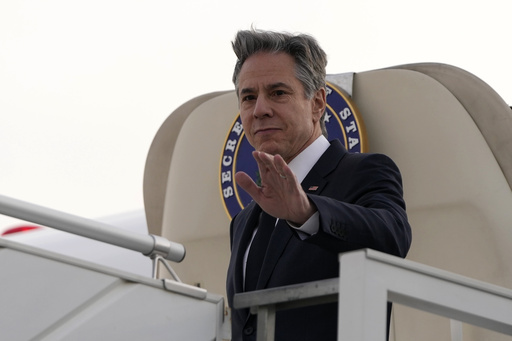Blinken returns to Mideast for hostage deal, postwar Gaza plan

US Secretary of State Antony Blinken disembarks from the plane upon arriving at King Khalid International Airport in Riyadh, Saudi Arabia, Monday, Feb. 5, 2024. (AP Photo/Mark Schiefelbein, Pool)
RIYADH, Saudi Arabia — US Secretary of State Antony Blinken met with Saudi Arabia’s crown prince Monday at the start of his fifth visit to the Middle East since the outbreak of the war in Gaza, hoping to press ahead with a potential cease-fire deal and postwar planning while tamping down regional tensions.
But on all three fronts, he faces major challenges: Hamas and Israel are publicly at odds over key elements of a potential truce. Israel has dismissed U.S. calls for a path to a Palestinian state, and Iran’s militant allies in the region have shown little sign of being deterred by U.S. strikes.
In Gaza, meanwhile, Hamas has begun to re-emerge in some of the most devastated areas after Israeli forces pulled back, an indication that Israel’s central goal of crushing the group remains elusive. Video footage from the same areas shows vast destruction, with nearly every building damaged or destroyed.
READ: Blinken urges Israel to engage with region on plans for postwar Gaza
Israeli Defense Minister Yoav Gallant said the military would continue to conduct operations in northern Gaza for many months and press ahead with its main offensive in the south, where it has been locked in heavy fighting for weeks until it has “full reign” over the entire territory.
He said the offensive will eventually reach the town of Rafah, on the Egyptian border, where some 1.5 million displaced Palestinians have sought refuge. Egypt has said an Israeli deployment along the border would threaten the peace treaty the two countries signed over four decades ago.
Article continues after this advertisementBlinken met with Crown Prince Mohammed bin Salman shortly after arriving in the Saudi capital, Riyadh. Saudi officials have said the kingdom is still interested in normalizing relations with Israel in a potentially historic deal, but only if there is a credible plan to create a Palestinian state.
Article continues after this advertisementBlinken “underscored the importance of addressing humanitarian needs in Gaza and preventing further spread of the conflict,” and he and the crown prince discussed “the importance of building a more integrated and prosperous region,” the State Department said in a statement.
But any such grand bargain appears a long way off as the war still rages in Gaza, where 113 bodies were brought to hospitals in the last 24 hours alone, according to the Health Ministry in the Hamas-ruled territory. Another 205 people were wounded, the agency said.
READ: Gaza in 2024: Signs of more devastation, open-ended occupation
The fatalities bring the overall Palestinian death toll from nearly four months of war to 27,478. The ministry does not distinguish between civilians and combatants in its count but says most of the dead have been women and children.
The war has leveled vast swaths of the tiny enclave, displaced 85% of its population of 2.3 million Palestinians, and pushed a quarter of residents to starvation.
Hamas returns to war-battered streets
A video circulating online Monday showed masked gunmen leading a line of shirtless detainees past bombed-out buildings in northern Gaza, forcing them to shout out that they were thieves. The Associated Press could not independently confirm the incident, but it is consistent with AP reporting.
It was the latest sign that Hamas, which has ruled Gaza since seizing power from rival Palestinian forces in 2007, is reasserting control in parts of the north. Residents say Hamas-led security forces, which numbered in the tens of thousands before the war, have begun to reappear in some areas where they focus on distributing civil salaries and cracking down on looters.
The Israeli military says it has launched targeted operations in northern Gaza over the last week to prevent Hamas from rebuilding its capabilities.
Prime Minister Benjamin Netanyahu has vowed to continue the war until Israel crushes Hamas’ military and governing abilities and wins the return of the 100-plus hostages still held by the militant group after the Oct. 7 cross-border raid that ignited the war.
Hamas and other militants killed some 1,200 people, mostly civilians, in the attack and abducted around 250. More than 100 captives, mostly women and children, were released during a weeklong cease-fire in November in exchange for the release of 240 Palestinians imprisoned by Israel.
Meeting with troops on Monday, Netanyahu said Israel had defeated 18 of Hamas’ 24 battalions without providing evidence. “We are on the way to absolute victory, and I want to tell you that we are committed to it, and we will not give it up.”
Ceasefire talks advance, but gaps remain
The United States, Qatar and Egypt have drawn up a proposal for a cease-fire of several weeks and the phased release of the remainder of the hostages.
But Hamas, which has yet to respond to the proposal publicly, has said it won’t release any more captives until Israel ends its offensive. The militants are expected to demand the release of thousands of Palestinian prisoners in return — demands Netanyahu has publicly ruled out.
The war has ignited tensions across the region, with a flurry of strikes and counterstrikes raising the risk of a wider conflict.
Israel and Lebanon’s powerful Hezbollah militant group trade fire across the border on a daily basis, and in recent weeks apparent Israeli strikes have killed senior Hezbollah commanders.
A drone attack launched by Iran-backed militants killed three U.S. soldiers near the Jordan-Syria border last week, prompting a wave of retaliatory U.S. strikes. The United States and Britain have also carried out strikes on the Iran-backed Houthi rebels in Yemen in response to their attacks on international shipping in the Red Sea, which the rebels portray as a blockade of Israel.